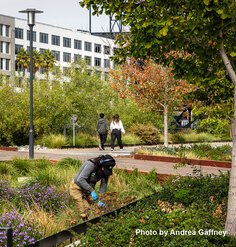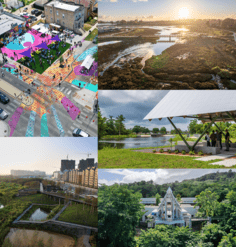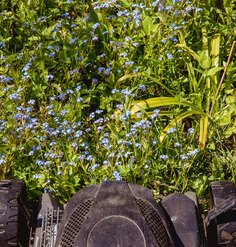U.S. Coast Guard Headquarters Study Complete
From October 2014 through September 2015, the Landscape Architecture Foundation (LAF) partnered with the General Services Administration (GSA) to evaluate the performance of the U.S. Coast Guard Headquarters site on the St. Elizabeth’s West campus in southeast Washington, DC, the largest federal redevelopment project since the Pentagon. This acclaimed project earned LEED Gold certification and features an extensive stormwater management system.
GSA is charged with providing workplaces for the federal government by constructing, managing, and preserving government buildings and by leasing and managing commercial real estate. Because GSA has committed to incorporate sustainability principles — including sustainable site design and management — in all of its real estate transactions, the agency was interested in studying the U.S. Coast Guard Headquarters site to test assumptions, assess materials, and understand the built condition.
The collaboration followed the model of LAF’s award-winning Case Study Investigation (CSI) program, with an academic team (Professor Christopher D. Ellis, Ph.D. and student research assistant C. Dylan Reilly of the University of Maryland) leading the research and members of the design team (Emily McCoy of Andropogon and Brandon Hartz of HOK) lending their insights. Because of the longer timeframe, the partnership provided the opportunity for a more expansive study than what is possible through the 6-month CSI program.
The year-long partnership allowed the 31-acre site to be studied through all four seasons in order to achieve a more balanced and nuanced picture of its performance. The research looked at a variety of ecosystem services provided by the site’s most notable features: 985 new trees, over 400,000 sf of green roofs, and a 2.4-acre stormwater pond. It also assessed workers’ use of and satisfaction with the outdoor open spaces, and use of alternate modes of transportation.
The researchers used temperature loggers to record and compare surface temperatures on areas of conventional black rubber roof, sedum green roof, and green roof planted with tall grass. They also compared native plant species and average site surface temperatures to those at a traditional office landscape. For the two courtyards, they used time-lapse photography to quantify the number of people using the space and determine the most common uses. They also observed commuter traffic to document the modes used and conducted a survey of employees to determine their satisfaction with the outdoor spaces.
The products of this collaboration are a Landscape Performance Series Case Study Brief and an internal report for GSA that discusses performance, provides recommendations for site management and maintenance, and suggests areas for further research.
LAF was proud to be part of this important study and will continue to pursue opportunities for longer-term research partnerships to evaluate the performance of exemplary built landscapes.











